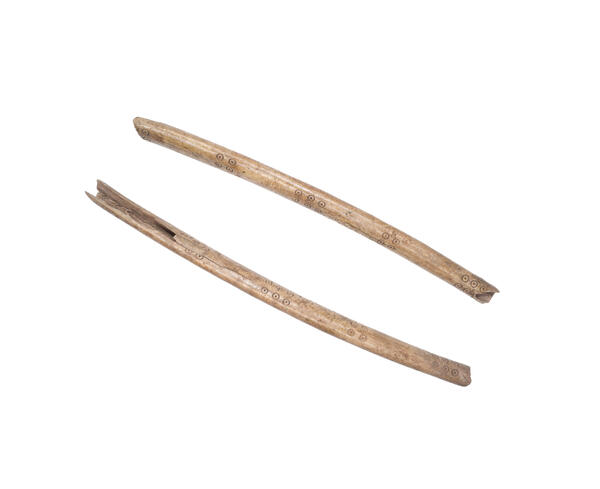In prehistoric times, sewing needles were stored in needlecases made of tubular bones of large birds.
Bone needlecases were common not just in settlements near Lake Baikal. Scientists found similar objects at archaeological sites in different places that were dated to the Neolithic and Paleometallic eras: starting from Western Siberia, Chukotka, Primorye, Kamchatka, Sakhalin and Hokkaido and all the way to Northwestern America. Therefore, it is believed that needlecases were used in many cultures from the Stone Age to the Middle Ages. In different periods, only the material from which such objects were made changed.
During the period when people started using metals (about 3000-2000 BC), along with bone, metal needlecases appeared in about the same shapes and sizes. In the burials of the Glazkov culture, tube needlecases can be found — they are rolled up from flattened thin sheets of copper.
Needlecases of a similar shape were made by many peoples: Lapps, Tunguses, Gilyaks, Ainu. The Chukchi (small-numbered indigenous people of the extreme northeast of Asia), for example, used metal needlecases until the beginning of the 20th century. Needlecases were created according to the Eskimo model: hollow tubes, in which iron needles were stored, were placed in a piece of seal skin. A special strap with a ball at the end was passed through the case. Needles were fixed at one end, and a hook made of walrus tusk, which was clung to the belt of one’s clothes, was at the other.
Unlike the cases, needles manufacturing methods and their design did not change over time. Threads from animal tendons were used for sewing clothes and creating inventory — they were valued for their strength and durability.
The indigenous peoples of the Lower Amur — Nanais, Orochi, Negidals, Ulchi, — in addition to traditional vein threads, were also able to make threads from fish skin, swim bladder of a large fish, blood arteries of deer or moose, as well as from plant fibers. For example, from nettles: the plant was collected in the fall, and then dried and kneaded in a wooden mortar or crushed with stones. Sometimes the threads were painted with natural dyes: an infusion of berries, herbs, roots or bark.
Bone needlecases were common not just in settlements near Lake Baikal. Scientists found similar objects at archaeological sites in different places that were dated to the Neolithic and Paleometallic eras: starting from Western Siberia, Chukotka, Primorye, Kamchatka, Sakhalin and Hokkaido and all the way to Northwestern America. Therefore, it is believed that needlecases were used in many cultures from the Stone Age to the Middle Ages. In different periods, only the material from which such objects were made changed.
During the period when people started using metals (about 3000-2000 BC), along with bone, metal needlecases appeared in about the same shapes and sizes. In the burials of the Glazkov culture, tube needlecases can be found — they are rolled up from flattened thin sheets of copper.
Needlecases of a similar shape were made by many peoples: Lapps, Tunguses, Gilyaks, Ainu. The Chukchi (small-numbered indigenous people of the extreme northeast of Asia), for example, used metal needlecases until the beginning of the 20th century. Needlecases were created according to the Eskimo model: hollow tubes, in which iron needles were stored, were placed in a piece of seal skin. A special strap with a ball at the end was passed through the case. Needles were fixed at one end, and a hook made of walrus tusk, which was clung to the belt of one’s clothes, was at the other.
Unlike the cases, needles manufacturing methods and their design did not change over time. Threads from animal tendons were used for sewing clothes and creating inventory — they were valued for their strength and durability.
The indigenous peoples of the Lower Amur — Nanais, Orochi, Negidals, Ulchi, — in addition to traditional vein threads, were also able to make threads from fish skin, swim bladder of a large fish, blood arteries of deer or moose, as well as from plant fibers. For example, from nettles: the plant was collected in the fall, and then dried and kneaded in a wooden mortar or crushed with stones. Sometimes the threads were painted with natural dyes: an infusion of berries, herbs, roots or bark.


